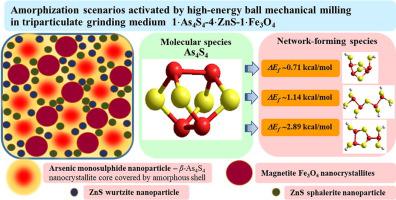Advanced Powder Technology ( IF 5.2 ) Pub Date : 2020-07-30 , DOI: 10.1016/j.apt.2020.07.008 Oleh Shpotyuk , Zdenka Lukáčová Bujňáková , Peter Baláž , Yaroslav Shpotyuk , Pavlo Demchenko , Valentina Balitska

|
Amorphization scenarios in multiparticulate grinding media composed of As4S4/ZnS/Fe3O4 nanocomposites driven by high-energy ball mechanical milling are identified employing the X-ray powder diffraction analysis on intermediate-range ordering in the generated amorphous phase. This amorphous phase is supposed to be nucleated heterogeneously from grain boundaries of β-As4S4 crystallites followed by penetration deeply into grain interior, stabilizing the crystalline-amorphous core-shell structure of the fine-grained nanoparticles. Coexistence of nanocrystalline nc-β-As4S4 and amorphous arsenic monosulphide a-AsS phases is crucial feature of these nanocomposites, the amorphous substance being generated continuously due to re-amorphization of disordered phase initially existed in arsenic sulphide prepared by synthesis from elements and direct milling-driven vitrification of nc-β-As4S4. In monoparticulate β-As4S4-based and biparticulate As4S4/Fe3O4 nanocomposites, the amorphizing configurations are composed of single- and triple-broken chain-like network clusters. Under stronger conditions realized in the grinding medium composed by hard nanoparticles biased by their sizes in respect to 20:1 rule, as in triparticulate 1⋅As4S4-4⋅ZnS-1⋅Fe3O4 nanocomposite, the amorphization scenario differs being activated by double-breaking of intramolecular covalent bonds within As4S4 cage-like molecules. This effect is identified as nanocrystalline nc-ZnS-assisted milling-driven arsenic monosulphide amorphization in triparticulate 1⋅β-As4S4-4⋅ZnS-1⋅Fe3O4 nanocomposite solution.
中文翻译:

研磨介质对As 4 S 4 / ZnS / Fe 3 O 4纳米复合材料中高能球磨驱动非晶化的影响
利用X射线粉末衍射分析法对生成的非晶相中的中间有序化,确定了由高能球机械研磨驱动的由As 4 S 4 / ZnS / Fe 3 O 4纳米复合材料组成的多颗粒研磨介质中的非晶化情况。该非晶相被认为是从β- As 4 S 4晶粒的晶界异质成核,然后深深渗透到晶粒内部,从而稳定了细颗粒纳米粒子的晶体-非晶核-壳结构。纳米晶nc- β- As 4 S 4的共存这些纳米复合材料的关键特征是无定形单硫化砷a-AsS相,无定形物质是由于无序相的重新非晶化而不断产生的,该无序相最初存在于通过元素合成和直接研磨驱动nc- β的玻璃化而制备的硫化砷中。作为4 S 4。在monoparticulate β -As 4小号4基和biparticulate作为4小号4 / Fe的3 ö 4纳米复合材料,非晶态结构由单断裂和三断裂链状网络簇组成。下通过可以通过在相对于尺寸偏置到20硬质纳米颗粒构成的研磨介质来实现更强的条件:1个规则,如在triparticulate1⋅As 4小号4 -4⋅ZnS-1⋅Fe 3 ö 4的纳米复合材料,非晶化方案的不同之被As 4 S 4笼状分子内的分子内共价键双断裂激活。这种效应被识别为纳米晶NC-的ZnS辅助碾磨驱动砷单硫化物在非晶triparticulate1⋅β-作为4小号4 -4⋅ZnS-1⋅Fe 3 ö4纳米复合溶液。



























 京公网安备 11010802027423号
京公网安备 11010802027423号